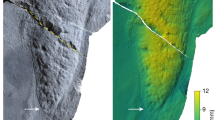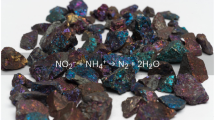Abstract
ALTHOUGH many species of fish ingest large amounts of detritus, its nutritional value has been questioned frequently1,2. Detritus in marine and freshwater habitats consists of a mixture of plant debris and amorphous organic matter together with associated heterotrophic and autotrophic microorganisms3. In detritus which does not contain large amounts of undegraded vascular plant matter, most of the protein is associated with heterotrophic microorganisms5–8. This is particularly true in fresh water9. Thus, the value of detritus as a food for fish depends to a large extent on their ability to digest heterotrophic microorganisms. It has been suggested that fish which consume detritus may have this ability4. Using 14C-labelled bacteria in in vitro experiments I have now demonstrated it in Sarotherodon mossambicus.
This is a preview of subscription content, access via your institution
Access options
Subscribe to this journal
Receive 51 print issues and online access
$199.00 per year
only $3.90 per issue
Buy this article
- Purchase on Springer Link
- Instant access to full article PDF
Prices may be subject to local taxes which are calculated during checkout
Similar content being viewed by others
References
Fish, G. R., Uganda J., 19, 85–89 (1955).
Odum, W. E., dissertation, Univ. Miami, cited in Mann, K. H., Mem. Ist. Ital. Idrobiol., 29, Suppl., 353–383 (1972).
Mann, K. H., Mem. 1st. Ital. Idrobiol., 29, Suppl., 13–16 (1972).
Odum, W. E., in Marine Food Chains (edit. by Steele, J. H.), 222–240 (University of California Press, 1970).
Newell, R., Proc. zool. Soc. Lond., 144, 25–45 (1965).
Odum, E. P., and de la Cruz, A. A., in Estuaries (edit. by Lauff, G. H.), 383–388 (American Association for the Advancement of Science, Washington DC, 1967).
Heald, E. J., thesis, Univ. Miami, cited in Mann, K. H., Mem. 1st. Ital. Idrobiol., 29 Suppl., 353–383 (1972).
Calow, P., Hydrobiologia, 46, 181–189 (1975).
Wiebe, W. J., and Pomeroy, L. R., Mem. 1st. Ital. Idrobiol., 29, Suppl., 325–352 (1972).
Fish, G. R., Hydrobiologia, 15, 161–178 (1960).
Moriarty, D. J. W., J. Zool., 171, 25–39 (1973).
Anson, M. L., and Mirsky, A. E., J. gen. Physiol., 22, 79–89 (1932).
Wright, R. T., and Hobbie, J. E., Limnol. Oceanogr., 10, 22–28 (1965).
Nagase, G., Z. vergl. Physiol., 49, 270–284 (1964).
Author information
Authors and Affiliations
Rights and permissions
About this article
Cite this article
BOWEN, S. Mechanism for digestion of detrital bacteria by the cichlid fish Sarotherodon mossambicus (Peters). Nature 260, 137–138 (1976). https://doi.org/10.1038/260137a0
Received:
Accepted:
Issue Date:
DOI: https://doi.org/10.1038/260137a0
This article is cited by
-
Chitin-based barrier immunity and its loss predated mucus-colonization by indigenous gut microbiota
Nature Communications (2018)
-
The origin of particulate organic matter and the diet of tilapia from an estuarine ecosystem subjected to domestic wastewater discharge: fatty acid analysis approach
Aquatic Ecology (2009)
-
Carbohydrases in the digestive tract of the African bony-tongue Heterotis niloticus (Pisces: Osteoglossidae)
Hydrobiologia (1993)
-
Ingestion of bacteria in suspension Indian major carps (Catla catla, Labeo rohita) and Chinese carps (Hypophthalmichthys molitrix, Aristichthys nobilis)
Hydrobiologia (1993)
-
Stomach pH, feeding rhythm and ingestion rate in Oreochromis niloticus L. (Pisces: Cichlidae) in Lake Awasa, Ethiopia
Hydrobiologia (1989)
Comments
By submitting a comment you agree to abide by our Terms and Community Guidelines. If you find something abusive or that does not comply with our terms or guidelines please flag it as inappropriate.



